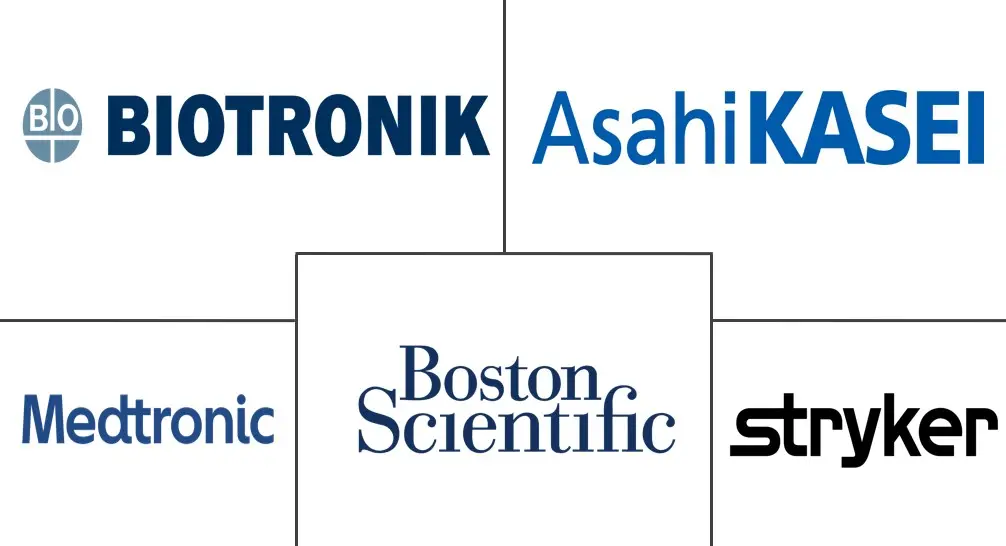Cardiac Implants Market Size and Share
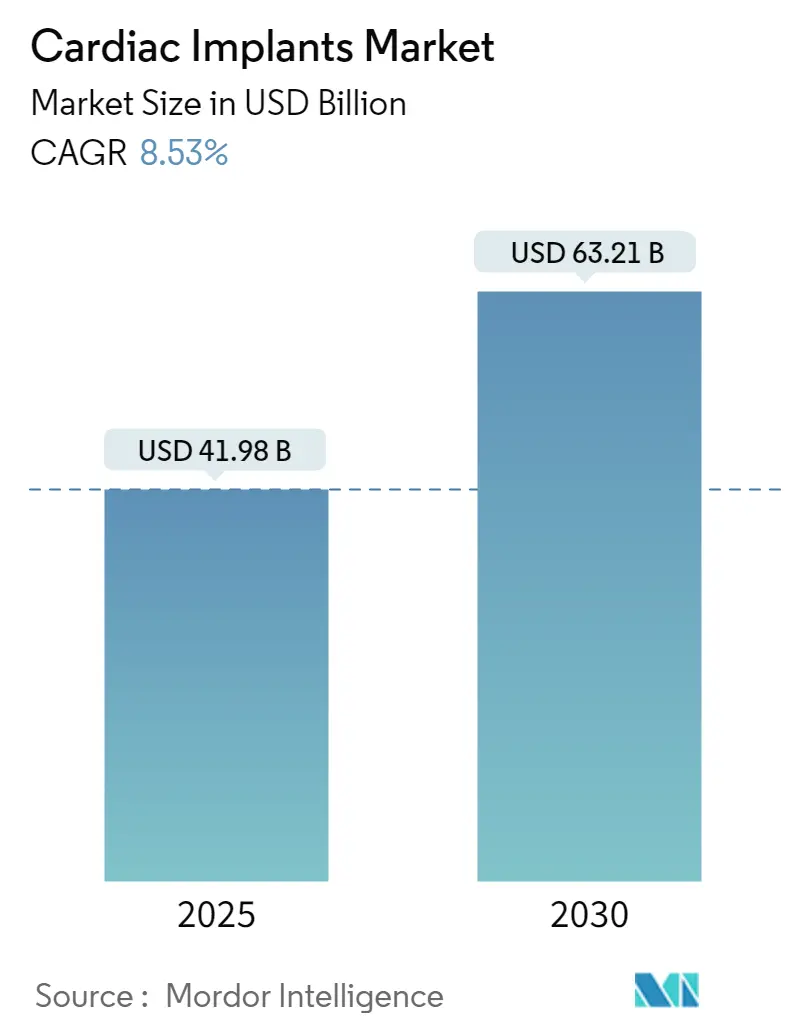
Cardiac Implants Market Analysis by Mordor Intelligence
The Cardiac Implants Market size is estimated at USD 41.98 billion in 2025, and is expected to reach USD 63.21 billion by 2030, at a CAGR of 8.53% during the forecast period (2025-2030).
The COVID-19 outbreak greatly impacted every aspect of the medical device industry, including the cardiac implants devices market. The number of patient visits during the pandemic was drastically reduced, despite having access to emergency care in the cardiology department. Even the treatment proximity to infected patients with COVID-19 was a challenge for cardiologists. Access was restricted to essential care only, and the temporary closure of cardiology centers considerably reduced cardiac surgeries, as the healthcare providers were engaged with COVID-19 patients. Major players in the cardiac implant industry, such as Medtronic PLC, reported a decline in revenue of 6 billion USD in Q4 2020. But the revenue was slightly increased by 1.6 billion USD in the fiscal year 2022 compared with the fiscal year 2021. This was due to the recovery of global procedure volumes from the downturn experienced in the first and second quarters of the fiscal year 2021 as a result of the COVID-19 pandemic. Hence, the impact of COVID-19 on the market's growth was adverse in the initial phase of the outbreak, however, as surgeries and treatments have resumed worldwide, the market is anticipated to gain traction to its pre-pandemic levels in the near future.
The increase in the incidence of cardiovascular diseases and the geriatric population are the driving factors for the cardiac implants market. For instance, as per the report of the American Heart Association published in February 2022, globally, it was estimated that in 2020, 244.1 million people had ischemic heart disease (IHD), and it was more prevalent in males than in females (141.0 and 103.1 million people, respectively). Likewise, according to the Centers for Disease Control and Prevention, in June 2022 update, about 20.1 million adults aged 20 and older had coronary heart disease (CAD) in 2020 in the United States. It also stated that coronary heart disease is the most common type of heart disease in the United States. Diabetes, overweight or obesity, an unhealthy diet, physical inactivity, and excessive alcohol use were the main causes of heart disease. As a result of the increasing frequency of heart illnesses worldwide, people who are affected by them are increasingly embracing surgical procedures, including cardiac implants, which is fueling the market's growth.
In addition, advancements in technology and new product approvals and launches drive the market's growth during the study period. For instance, in October 2020, Abbott launched its new implantable cardioverter defibrillator (ICD) and cardiac resynchronization therapy defibrillator (CRT-D) devices in India for abnormal heart rhythms and heart failure.
Hence, owing to the factors mentioned above, the market is expected to witness significant growth in the future. However, the high cost of cardiac implants and the side effects associated with cardiac implants are some of the factors that may restrain the market's growth.
Global Cardiac Implants Market Trends and Insights
Implantable Cardioverter-Defibrillators (ICDs) Segment is Expected to Grow Faster and Dominate the Market Over the Forecast Period
An implantable cardioverter-defibrillator (ICD) is a small battery-powered device placed in the chest to detect and stop irregular heartbeats (arrhythmias). It continuously monitors the heartbeat and delivers electric shocks, when needed, to restore a regular heart rhythm. The implantable cardioverter-defibrillators (ICDs) segment is expected to witness significant growth owing to factors such as increasing cases of cardiovascular diseases and increasing adoption of technologically advanced products.
According to the World Health Organization, in 2020, it is estimated that 17.9 million people die from cardiovascular diseases each year, which is 32% of all global deaths, of which 85% were due to heart attack and stroke. However, it is important to detect cardiovascular diseases as early as possible to minimize their effect on individuals.
Furthermore, as per the study conducted from 2020 to 2021 titled "Prevalence and risk of atrial fibrillation in China: A national cross-sectional epidemiological study" published in June 2022, the prevalence of atrial fibrillation was 1.6% in the Chinese adult population and increased with age. By considering the increase in the prevalence of heart diseases with an increase in the geriatric population, the scope for heart procedures, especially cardiac implants, is estimated to grow over the coming years. Moreover, in January 2020, Medtronic plc received the CE (Conformité Européenne) mark for its Cobalt and Crome portfolio of implantable cardioverter-defibrillators (ICD).
Thus, considering the abovementioned factors, the implantable cardioverter-defibrillators (ICDs) segment is expected to grow over the forecast period.
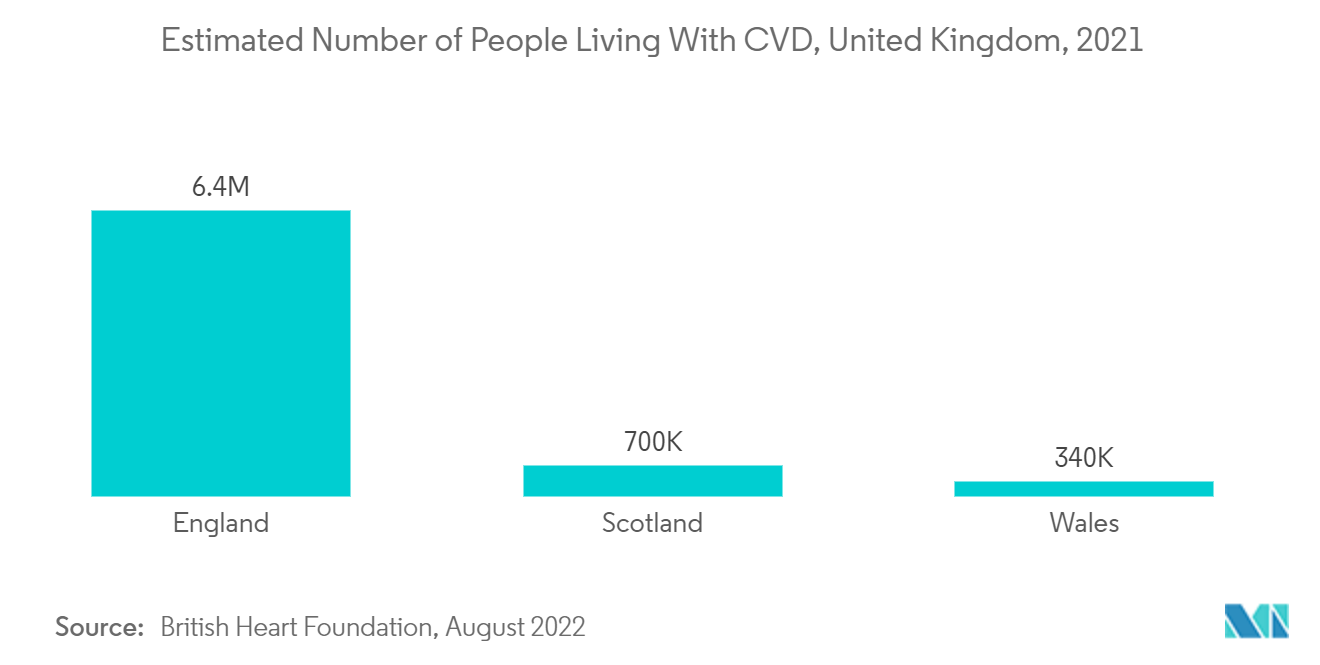
North America Dominates the Market and is Expected to do Same in the Forecast Period
North America holds the major market share in the cardiac implants market. According to the Centers for Disease Control and Prevention (CDC) updated report 2022, the number of deaths reported due to heart diseases was 659,041 in 2019 and increased to 690,882 in 2020 in the United States. The Centers for Disease Control and Prevention (CDC) stated that the key risk factors for heart disease and stroke are high blood pressure, diabetes, high LDL (bad) cholesterol, and smoking. Also, according to the same above-mentioned source, it is estimated that 12.1 million people in the United States will have atrial fibrillation by 2030. Thus, an increase in the prevalence of cardiovascular diseases will have a positive impact on the usage of cardiac implants and drive the market growth.
New product approvals and launches by the prominent players operating in the market are anticipated to further boost the market's growth in the region. For instance, in February 2022, Abbott received expanded indication approval for the CardioMEMS HF System from the United States Food and Drug Administration (FDA) to support the care of more people living with heart failure. The CardioMEMS HF System is a paperclip-sized sensor implanted in a patient's pulmonary artery using a catheter. Also, in April 2022, Abbott received approval from the United States Food and Drug Administration (FDA) for the Aveir single-chamber (VR) leadless pacemaker for the treatment of patients in the United States with slow heart rhythms.
Hence, due to the factors mentioned above and new approvals and launches, North America is expected to witness significant growth in the market over the forecast period.
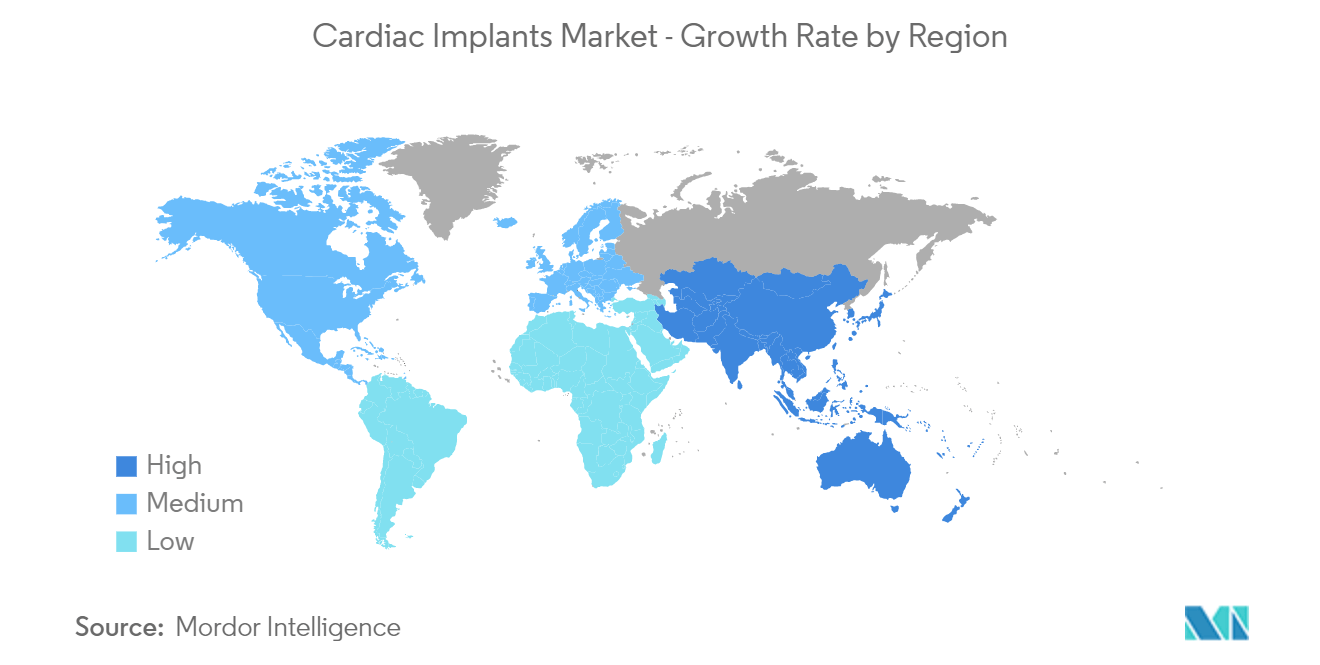
Competitive Landscape
The cardiac implants market is consolidated in nature with prominent players across the world. In terms of market share, a few of the major players currently dominate the market. The cardiac implant companies are focusing more on new product development to provide technologically advanced solutions to patients, which is boosting the competition among the key players. Some of the major players in the market are Medtronic, Boston Scientific Corporation, Stryker (Physio-Control Inc.), Biotronik, Asahi Kasei Corporation (ZOLL Medical Corporation), Pacetronix.com, Schiller AG, Koninklijke Philips NV, LivaNova PLC, Abbott, Impulse Dynamics, and Angel Medical Systems, Inc.
Cardiac Implants Industry Leaders
-
Boston Scientific Corporation
-
Stryker Corporation (Physio-Control Inc.)
-
Biotronik
-
Medtronic
-
Asahi Kasei Corporation (Zoll Medical Corporation)
- *Disclaimer: Major Players sorted in no particular order
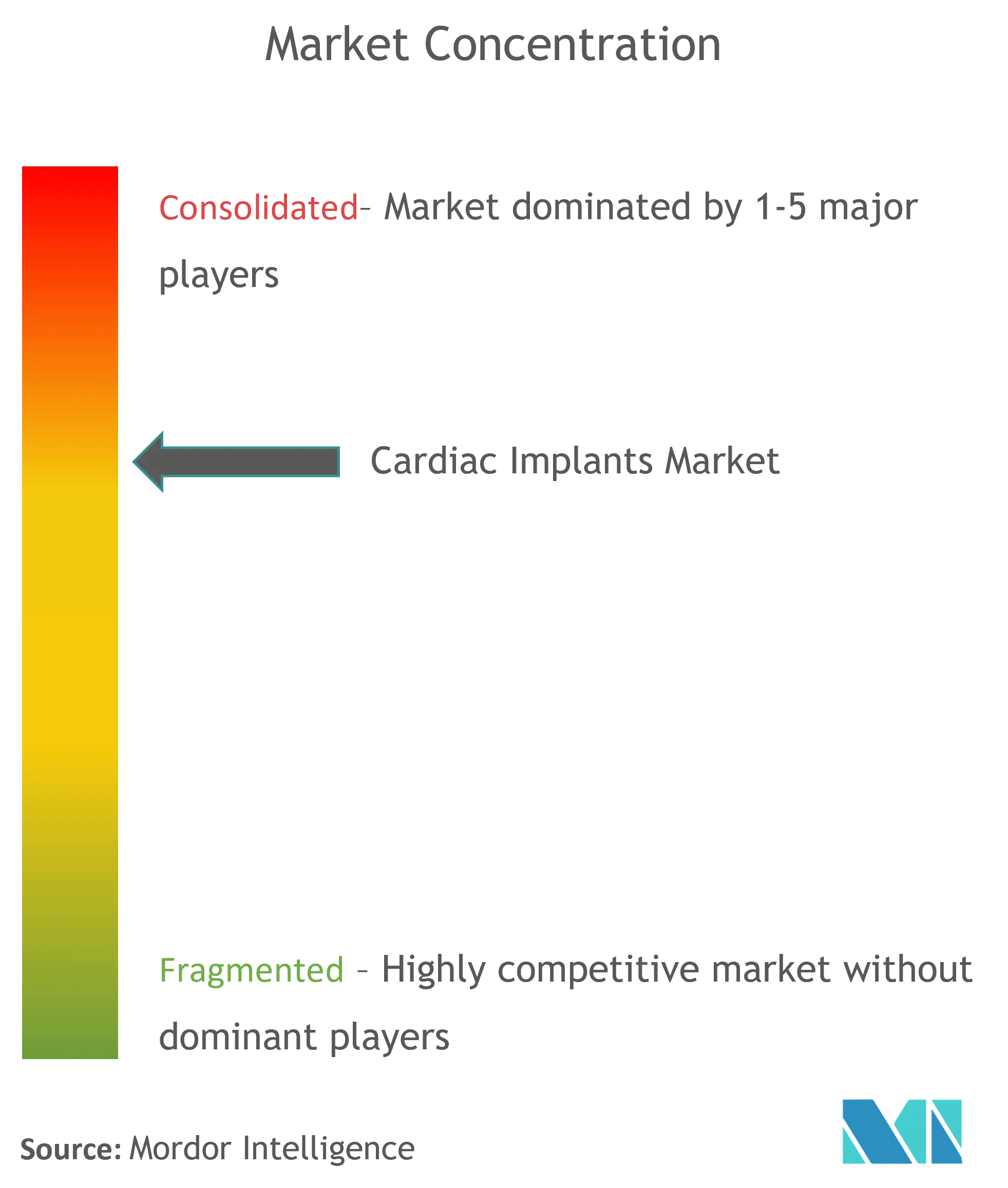
Recent Industry Developments
- In April 2022, Impulse Dynamics received approval and launched the Optimizer Smart Mini in the United States. The Optimizer Smart Mini Implantable Pulse Generator (IPG) is a Class III medical device intended for the treatment of moderate to severe heart failure.
- In July 2021, Angel Medical Systems, Inc., launched its flagship product, the Guardian device. The Guardian System is the first implantable cardiac detection monitor and patient-warning system indicated for acute coronary syndrome (ACS) events, including silent heart attacks.
Global Cardiac Implants Market Report Scope
As per the scope of the report, the cardiac implant is a mechanical circulatory support device that helps pump blood from the heart to the rest of the body. Cardiac implants are used for individuals with a weak heart or heart failure and diseases like atherosclerosis, congestive heart failure, coronary artery disease, hypertension, and vascular stenosis. The cardiac implants market is segmented by product (implantable cardioverter-defibrillators (ICDs), pacemakers, coronary stents, implantable heart rhythm monitors, implantable hemodynamic monitors, and other products), application (arrhythmias, acute myocardial infarction, myocardial ischemia, and other applications), end user (hospitals, cardiology centers, and other end users), and geography (North America, Europe, Asia Pacific, Middle East & Africa, and South America). The market report also covers the estimated market sizes and trends for 17 different countries across major regions, globally. The report offers the value (in USD million) for the above segments.
| Implantable Cardioverter-defibrillators (ICDs) |
| Pacemakers |
| Coronary Stents |
| Implantable Heart Rhythm Monitors |
| Implantable Hemodynamic Monitors |
| Other Products |
| Arrhythmias |
| Acute Myocardial Infarction |
| Myocardial Ischemia |
| Other Applications |
| Hospitals |
| Cardiology Centers |
| Other End Users |
| North America | United States |
| Canada | |
| Mexico | |
| Europe | Germany |
| United Kingdom | |
| France | |
| Italy | |
| Spain | |
| Rest of Europe | |
| Asia Pacific | China |
| Japan | |
| India | |
| Australia | |
| South Korea | |
| Rest of Asia Pacific | |
| Middle-East and Africa | GCC |
| South Africa | |
| Rest of Middle East & Africa | |
| South America | Brazil |
| Argentina | |
| Rest of South America |
| By Product | Implantable Cardioverter-defibrillators (ICDs) | |
| Pacemakers | ||
| Coronary Stents | ||
| Implantable Heart Rhythm Monitors | ||
| Implantable Hemodynamic Monitors | ||
| Other Products | ||
| By Application | Arrhythmias | |
| Acute Myocardial Infarction | ||
| Myocardial Ischemia | ||
| Other Applications | ||
| By End Users | Hospitals | |
| Cardiology Centers | ||
| Other End Users | ||
| By Geography | North America | United States |
| Canada | ||
| Mexico | ||
| Europe | Germany | |
| United Kingdom | ||
| France | ||
| Italy | ||
| Spain | ||
| Rest of Europe | ||
| Asia Pacific | China | |
| Japan | ||
| India | ||
| Australia | ||
| South Korea | ||
| Rest of Asia Pacific | ||
| Middle-East and Africa | GCC | |
| South Africa | ||
| Rest of Middle East & Africa | ||
| South America | Brazil | |
| Argentina | ||
| Rest of South America | ||
Key Questions Answered in the Report
How big is the Cardiac Implants Market?
The Cardiac Implants Market size is expected to reach USD 41.98 billion in 2025 and grow at a CAGR of 8.53% to reach USD 63.21 billion by 2030.
What is the current Cardiac Implants Market size?
In 2025, the Cardiac Implants Market size is expected to reach USD 41.98 billion.
Who are the key players in Cardiac Implants Market?
Boston Scientific Corporation, Stryker Corporation (Physio-Control Inc.), Biotronik, Medtronic and Asahi Kasei Corporation (Zoll Medical Corporation) are the major companies operating in the Cardiac Implants Market.
Which is the fastest growing region in Cardiac Implants Market?
Asia-Pacific is estimated to grow at the highest CAGR over the forecast period (2025-2030).
Which region has the biggest share in Cardiac Implants Market?
In 2025, the North America accounts for the largest market share in Cardiac Implants Market.
What years does this Cardiac Implants Market cover, and what was the market size in 2024?
In 2024, the Cardiac Implants Market size was estimated at USD 38.40 billion. The report covers the Cardiac Implants Market historical market size for years: 2019, 2020, 2021, 2022, 2023 and 2024. The report also forecasts the Cardiac Implants Market size for years: 2025, 2026, 2027, 2028, 2029 and 2030.
Page last updated on:
Cardiac Implants Market Report
Statistics for the 2025 Cardiac Implants market share, size and revenue growth rate, created by Mordor Intelligence™ Industry Reports. Cardiac Implants analysis includes a market forecast outlook for 2025 to 2030 and historical overview. Get a sample of this industry analysis as a free report PDF download.
